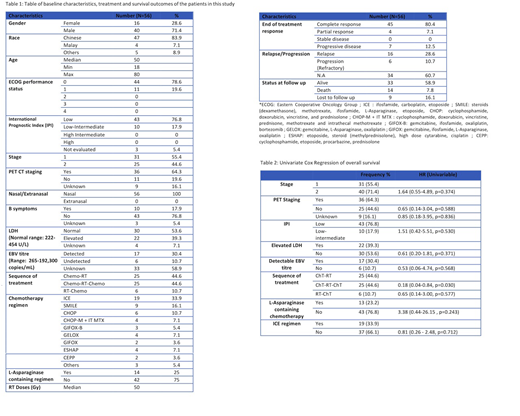Background:
Extranodal natural killer/T cell lymphoma (ENKL) is an aggressive Epstein-Barr virus (EBV) associated lymphoma with a strong geographical predilection for Asia and South America. While treatment outcomes of advanced stage (AS) disease (i.e., stage III and IV) are uniformly poor, early stage (ES) disease treated with concomitant or sequential chemotherapy (ChT) and radiotherapy (RT) can yield good long-term outcomes. Currently there is no standard therapy for ES ENKL. We describe our experience treating patients with ES ENKL in 3 tertiary cancer centres in Singapore.
Method:
We performed a retrospective analysis using data from Singapore Lymphoma Study Group database which captures patients from 3 largest tertiary cancer centres in Singapore: National Cancer Centre Singapore (NCCS), Singapore General Hospital (SGH) and National University Cancer Institute, Singapore (NCIS). We included patients with stage I or II ENKL that were treated with ChT and RT from 1996 to March 2019. Patients who did not receive treatment or received radiotherapy alone were excluded. We recorded data on patient demographics, chemotherapy regimen, radiotherapy dosage, sequencing of treatment, response and survival outcomes. End of treatment overall response rates (ORR) included those who achieved complete response (CR) and a partial response (PR). Progression free survival (PFS) was defined as date of diagnosis to date of progression, relapse or death. Overall survival (OS) was defined as date of diagnosis to date of death from all causes. Survival distributions were estimated by the Kaplan-Meier method. Assuming cox proportional hazards models, univariate analysis for OS was performed and Wald tests were used to evaluate the statistical significance. All the statistical analysis was performed using R.
Results:
There were 56 patients who fulfilled the inclusion criteria. Forty (71%) were male, 47 (84%) were Chinese and the median age of this cohort was 50 (range 18-80). Thirty-one (55%) patients had stage I disease and all had nasal involvement. All patients had ECOG performance status of 0 or 1 and most had low or low-intermediate international prognostic index (IPI) score. Ten patients (18%) had B-symptoms and LDH was elevated in 22 (39%). Pre-treatment positron emission tomography-computed tomography (PET/CT) was performed in 36 (64%) patients. Pre-treatment EBV titres were tested in only 23 patients and they were detected in 17 (74%) of patients. Twenty-five patients (45%) had sandwich (ChT, RT then ChT), 25 (45%) had ChT followed by RT, while 6 had RT followed by ChT. None had concurrent ChT/RT. The most commonly used ChT regimen was ICE (ifosfamide, carboplatin, etoposide) in 19 patients and SMILE (steroids, methotrexate, ifosfamide, L-asparaginase, etoposide) was used in 9 patients. Most patients (75%) did not receive L-asparaginase containing regimens. The median RT dose was 50Gy. The ORR for this cohort was 87.5% and 7 patients (12.5%) progressed at the end of treatment. Our median duration of follow up is 3.5 years (range: 0.25 - 21.6 years). The 5-year OS for stage I and II disease were 78.5% (95% CI, 64.2%-96.0%) and 65.6% (95% CI 47.5% to 90.5%) respectively. The 5-year PFS for stage I and II disease was 78.5% (95% CI 64.2%-96.0%) and 58.8% (95% CI 40.9% to 84.5%) respectively. On univariate analysis, only the sequence of therapy i.e., the sandwich ChT-RT-ChT approach when compared to sequential treatment with ChT followed by RT, was associated with better OS with a hazard ratio (HR) of 0.18 (95% CI 0.04 to 0.84 , p = 0.03). When L-asparaginase containing regimens were compared against those without, no statistical significant difference was observed in OS in ES ENKL, with HR of 3.38 (95%CI 0.44-26.15, p=0.243)
Conclusion:
Survival outcomes for ES ENKL especially that of stage I ENKL, are good with chemoradiotherapy. This contrasts against the treatment outcomes of AS ENKL. It is likely that many patients in this study were under-staged since PET scans were only performed in 64% of patients. Within the limits of this retrospective analysis and the small numbers, the ICE chemotherapy regimen appears to be an effective treatment when "sandwich"-sequenced with radiotherapy.
Lim:National Cancer Centre Singapore: Employment.
Author notes
Asterisk with author names denotes non-ASH members.


